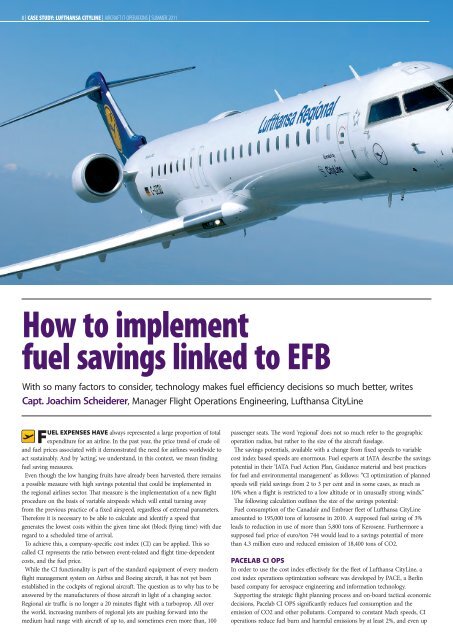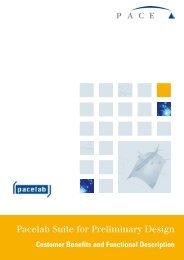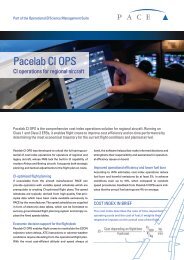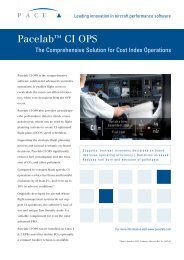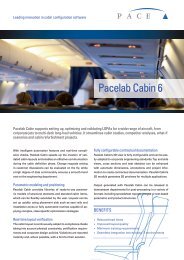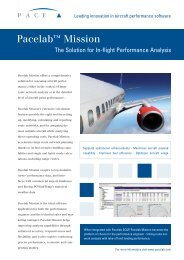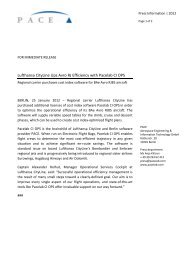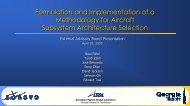Case Study: Lufthansa CityLine | Aircraft IT Operations ... - Pace
Case Study: Lufthansa CityLine | Aircraft IT Operations ... - Pace
Case Study: Lufthansa CityLine | Aircraft IT Operations ... - Pace
Create successful ePaper yourself
Turn your PDF publications into a flip-book with our unique Google optimized e-Paper software.
8 | CASE STUDY: LUFTHANSA C<strong>IT</strong>YLINE | AIRCRAFT <strong>IT</strong> OPERATIONS | SUMMER 2011<br />
How to implement<br />
fuel savings linked to EFB<br />
With so many factors to consider, technology makes fuel efficiency decisions so much better, writes<br />
Capt. Joachim Scheiderer, Manager Flight <strong>Operations</strong> Engineering, <strong>Lufthansa</strong> <strong>CityLine</strong><br />
FUEL EXPEnSES HAvE always represented a large proportion of total<br />
expenditure for an airline. In the past year, the price trend of crude oil<br />
and fuel prices associated with it demonstrated the need for airlines worldwide to<br />
act sustainably. And by ‘acting’, we understand, in this context, we mean finding<br />
fuel saving measures.<br />
Even though the low hanging fruits have already been harvested, there remains<br />
a possible measure with high savings potential that could be implemented in<br />
the regional airlines sector. That measure is the implementation of a new flight<br />
procedure on the basis of variable airspeeds which will entail turning away<br />
from the previous practice of a fixed airspeed, regardless of external parameters.<br />
Therefore it is necessary to be able to calculate and identify a speed that<br />
generates the lowest costs within the given time slot (block flying time) with due<br />
regard to a scheduled time of arrival.<br />
To achieve this, a company-specific cost index (CI) can be applied. This so<br />
called CI represents the ratio between event-related and flight time-dependent<br />
costs, and the fuel price.<br />
While the CI functionality is part of the standard equipment of every modern<br />
flight management system on Airbus and Boeing aircraft, it has not yet been<br />
established in the cockpits of regional aircraft. The question as to why has to be<br />
answered by the manufacturers of those aircraft in light of a changing sector.<br />
Regional air traffic is no longer a 20 minutes flight with a turboprop. All over<br />
the world, increasing numbers of regional jets are pushing forward into the<br />
medium haul range with aircraft of up to, and sometimes even more than, 100<br />
passenger seats. The word ‘regional’ does not so much refer to the geographic<br />
operation radius, but rather to the size of the aircraft fuselage.<br />
The savings potentials, available with a change from fixed speeds to variable<br />
cost index based speeds are enormous. Fuel experts at IATA describe the savings<br />
potential in their ‘IATA Fuel Action Plan, Guidance material and best practices<br />
for fuel and environmental management’ as follows: “CI optimization of planned<br />
speeds will yield savings from 2 to 3 per cent and in some cases, as much as<br />
10% when a flight is restricted to a low altitude or in unusually strong winds.”<br />
The following calculation outlines the size of the savings potential:<br />
Fuel consumption of the Canadair and Embraer fleet of <strong>Lufthansa</strong> <strong>CityLine</strong><br />
amounted to 195,000 tons of kerosene in 2010. A supposed fuel saving of 3%<br />
leads to reduction in use of more than 5,800 tons of Kerosene. Furthermore a<br />
supposed fuel price of euro/ton 744 would lead to a savings potential of more<br />
than 4.3 million euro and reduced emission of 18,400 tons of CO2.<br />
PACELAB CI OPS<br />
In order to use the cost index effectively for the fleet of <strong>Lufthansa</strong> <strong>CityLine</strong>, a<br />
cost index operations optimization software was developed by PACE, a Berlin<br />
based company for aerospace engineering and information technology.<br />
Supporting the strategic flight planning process and on-board tactical economic<br />
decisions, <strong>Pace</strong>lab CI OPS significantly reduces fuel consumption and the<br />
emission of CO2 and other pollutants. Compared to constant Mach speeds, CI<br />
operations reduce fuel burn and harmful emissions by at least 2%, and even up


